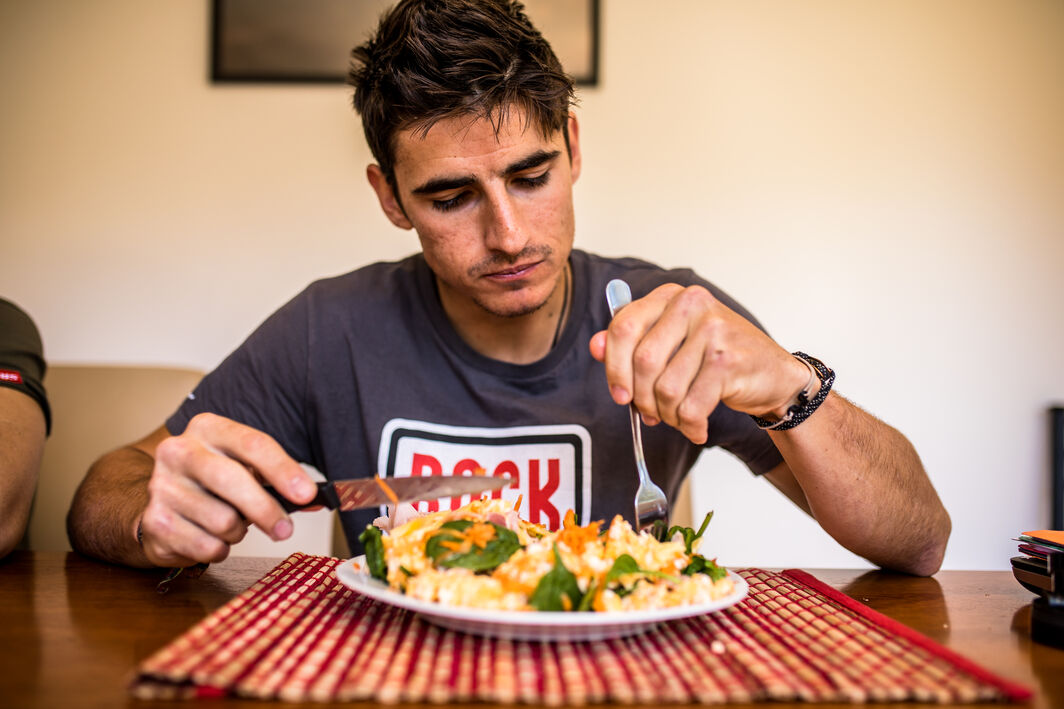Protein for cyclists
Protein is one of the three macronutrients that is needed for optimal cycling performance


We know you want to be the best cyclist you can be whether that’s sprinting for the line during a road race or completing your first full-distance triathlon. As well as training on and off the bike, nutrition is an important part of every top-level rider’s performance plan. Not only can a good nutrition plan help you reach the top step of the podium but it is vital in supporting your body to get there.
What is protein & why is it important?
Protein is one of the three macronutrients that is needed for optimal cycling performance. The building blocks of protein are known as amino acids. In total there are 20 amino acids, nine of which are essential meaning they need to be consumed in the diet. Protein is needed for all cells and muscle tissues to function as well as hormones, immunity and enzymes (proteins that help stimulate reactions in the body).
It not only maintains and increases muscle tissue but supports muscle contraction and movement, the formation of haemoglobin (a protein found in your blood that transports oxygen around the body), facilitates chemical reactions during digestion, supports the regulation and expression of genetic information and even helps support immune function. All of which are highly important for getting the most out of your training and racing.

How much protein do cyclists need?
It is well known that athletes have a greater need for protein depending on their training volume and intensity. This is due to the constant need to repair or replace protein structures that result in muscle damage during exercise. Protein intakes are independent of gender and are always set by grams per kilograms body weight. The general Recommended Daily Allowance (RDA) is set around 0.8 g/kg bodyweight per day for an average person.
However, the daily amount for people doing regular endurance cycling can be significantly increased to ~1.2-1.8 g/kg/d (1). Where your intake falls on this spectrum depends on your training plan, goals and individual needs.
-
Hobby athletes: 1.2-1.4g/ kg BW daily
-
Well trained endurance athletes: 1.4-1.6g/ kg BW daily
-
Top endurance athletes: 1.4-1.8g/ kg BW daily
High protein diets are often used for weight loss due to their thermogenic effects, as it uses a lot of energy to be digested and its satiety effects, which would naturally help reduce caloric intake. It is suggested that during caloric restriction, protein intakes should be increased to >2.0 g/kg/d and combined with resistance training to maintain muscle mass (2).
However, there is a limit to the amount of protein that provides benefits. Research shows amounts greater than 3.4 g/kg/d have no further benefits and is not necessary (2).
Are all proteins equal?
No. Protein sources can be divided into two categories, complete and incomplete. Complete proteins are most commonly sourced from animal proteins such as meat, fish, poultry, eggs and most dairy products and contain all the essential amino acids.
Whereas, incomplete proteins are those from plant sources such as beans, some grains, specific nuts and legumes. They need extra consideration, as they do not provide all essential amino acids and are best combined together to make a complete protein (3).
For example, beans with rice, nuts and seeds with soy yoghurt or hummus and pita bread are combinations including all essential amino acids. Certain plant sources such as chia seeds, hemp seeds and quinoa contain all the essential amino acids.
When is the best time of the day to eat protein?
Protein intakes are best consumed when spread throughout the whole day every 3-4 hours. This helps to maximise the functions of protein and to balance blood sugar levels over the course of the day.
To reach the daily intake you require as a cyclist, aim to eat a source of protein with every meal and snack you consume. This does not mean you need to have protein powder with every meal. Daily sources of protein should come from a wide range of sources that suit your dietary preference.
-
Grass-fed beef
-
Poultry
-
Eggs
-
Fish
-
Dairy
-
Tofu and tempeh
-
Nuts and seeds (specifically pumpkin, hemp, sunflower, chia and sesame seeds)
-
Legumes and beans
-
Grains such as quinoa, brown rice or buckwheat
-
Vegetables such as spinach and broccoli

How does protein help my recovery after cycling?
The use of protein for recovery is often misinterpreted. It is well known that to reap the rewards of training and to speed up recovery, it is vital that you consume protein directly after training. However, this is partly a myth. Results are mixed as to whether protein ´speeds up` short term recovery, as it does not reduce muscle soreness (a desired recovery effect). However, it may help accelerate glycogen restoration (stored energy) when not enough carbohydrates are consumed (this is still under debate).
Rather, protein is mainly needed after specific training sessions to stimulate muscle protein synthesis (MPS), which is key in maximising long-term training adaptations and can take many hours, days or weeks to achieve the desired effects.
What is the best type of protein for recovery?
As we know not all proteins are equal, there are sources that have shown to be superior to enhance the desired effects after exercise. Many research studies have shown that whey protein is the superior source of protein to maximise MPS. This is due to its fast-reacting effects, digestibility and high content of essential amino acids, specifically leucine. Leucine stimulates MPS by activating anabolic signalling (to build muscle tissue).
Vegan or plant-based cyclists can substitute whey with a powder from a combination of different plant proteins with great results, however the leucine content is lower (3).
So, do I need to have a protein powder after every training session?
No, this is not always necessary and is dependent on your goals. Although a protein powder is highly convenient, eating a balanced meal with ~20g of high-quality protein from wholefoods is sufficient for most training days. Following a high intensity or a strength session, consumption of protein powder within 1 hour of finishing the session can be beneficial to aid and maximise the effects of training.
According to research the superior protein strategy following such a session is to consume 20g of protein in four intervals approximately 2-3 hours apart (5). The study showed this strategy to potentially be more effective than 8 x 10g protein every 1.5 hours or 2 x 40g protein every 6 hours.

Michelle Reed is a nutritionist with a BSc (Honours) in Nutritional Science and Therapy from Middlesex University. As a mountain biker herself with a key interest in endurance sports, Michelle specialised in sports nutrition by completing her MSc in High Performance Sport from Saarland University and a Certificate of Integrative Sport Nutrition from the CISN.
She now offers valuable high-end nutritional advice and consultations to athletes around the world in particular road cyclists and mountain bikers.
You can find out more about her nutritional expertise on her website (www.mreednutrition.com) and social media platforms (@mreednutrition).
-
Jäger, R., Kerksick, C. M., Campbell, B. I., Cribb, P. J., Wells, S. D., Skwiat, T. M., ... Antonio, J. (2017). International Society of Sports Nutrition Position Stand: protein and exercise. Journal of the International Society of Sports Nutrition, 14(1), 20.
-
Protein series: Antonio et al (2014, 2015, 2016, 2016)
-
van Vliet S, Burd NA, van Loon LJ. (2015). The skeletal muscle anabolic response to plant- versus animal-based protein consumption. J Nutr. 145:9:1981-91.
-
Macnaughton LS, Wardle SL, Witard OC, McGlory C, Hamilton DL, Jeromson S, Lawrence CE, Wallis GA, Tipton KD. (2016). The response of muscle protein synthesis following whole-body resistance exercise is greater following 40 g than 20 g of ingested whey protein. Physiol Rep, 4(15).
-
Areta, J. L., Burke, L. M., Ross, M. L., Camera, D. M., West, D. W. D., Broad, E. M., … Coffey, V. G. (2013). Timing and distribution of protein ingestion during prolonged recovery from resistance exercise alters myofibrillar protein synthesis. The Journal of Physiology, 591(9), 2319–2331.
Did this article help?
Thank you for your feedback




